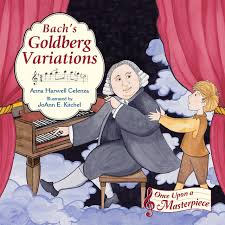Symphonic Variations
Listen to the Recess! Clip
| Author | John Cech |
| Air Date | 7/22/2005 |

Symphonic Variations Transcript
One of the fascinating stories in classical music has its beginning in this famous passage from Johann Sebastian Bach’s “Goldberg Variations”:
Brief Sound Clip:
These 32 short pieces were written in 1737 for an orphan and musical prodigy, Johann Gottlieb Goldberg, who was in the service of one of Bach’s friends, Count Keyserlingk. The nobleman wanted to hear the boy play a piece of music that “has everything. . . . a piece filled with dances and difficult runs. . . . and something quite new.” The story of Bach’s creation of this work for this talented boy is the subject of Anna Harwell Celenza’s Bach’s Goldberg Variations, the fourth in her series of books about the inspiration for famous works of music, including Mussorsky’s Pictures at an Exhibition, Haydn’s The Farewell Symphony, and Beethoven’s Heroic (or “Eroica”) Symphony. Each book, which comes with a CD of the music, tells a compelling story that opens these works up for young listeners. For instance, Haydn’s symphony grew out of the frustration and sadness that he and the group of musicians he directed felt because they were literally being worked to a frazzle by their patron, Prince Nicholas Esterhazy. Haydn even had the orchestra give the prince a kind of musical raspberry from the French horns in the thrid movement:
Brief Sound Clip:
And then there is Beethoven’s “Eroica” — which began as a celebration of Napoleon (whom Beethoven at first, like many others, considered to be a hero). But as Celenza explains, the symphony was really about Beethoven’s own growing deafness, and the work became emblematic of his own struggle to transcend his despair in order to continue to create the music he would soon be unable to hear:
Brief Sound Clip: